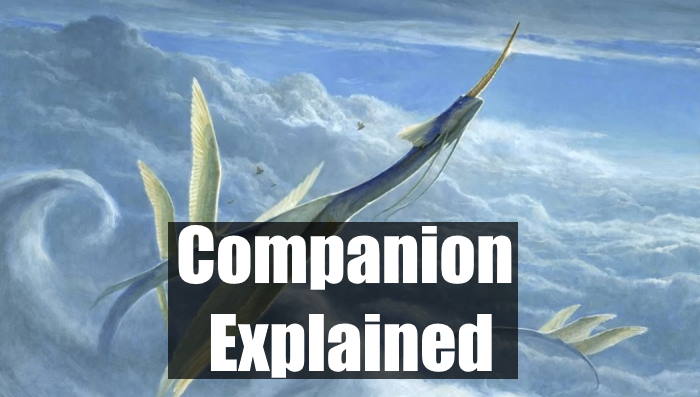Of all the popular Trading Card Games, Magic: the Gathering is almost certainly the most complex. MTG features a crazy number of abilities and mechanics on its cards, and learning them all can feel like quite the endeavor. In this article I’ll break down everything you need to know about the Companion ability.
Companion is a keyword ability featured on ten Legendary Creatures from Ikoria: Lair of Behmoths. You may choose to have these creatures start outside of your main deck where you’ll have access to them throughout the game. However, to use these creatures as Companions, you must abide by a certain deck-building restriction. Each creature with Companion imposes its own unique requirements which your starting deck must meet in order to use the creature as a Companion.
While Companion might not be the most confusing mechanic we’ve ever seen, it is quite complex. And to further complicate things, the rules surrounding Companion have also changed since they were first released. This article will cover it all while also giving you tips on the strongest Companions to build your next deck around!
How Does Companion Work?
Unlike other abilities in Magic history, the Companion mechanic starts during the deck-building process. Companion creatures require you to build your deck around a certain set of rules. Lurrus of the Dream-Den for example, lets you include only spells with mana-value 2 or less in your starting deck. Yorion, Sky Nomad, on the other hand, requires your starting deck to contain at least 20 more cards than the minimum deck size (so 80 cards for Modern, 60 cards for Draft etc.).
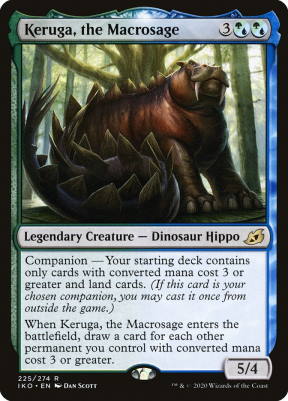
The chosen Companion creature is then placed in your sideboard outside of the game. If the deck-building requirements are met, the Companion can be brought from the sideboard to your hand. You can do this any time you could cast a sorcery, by paying 3 generic mana, in what’s known as a special action. A special action is an action that doesn’t use the stack and can’t be responded to.
Once you have the Companion safely in hand, it functions exactly like any other card. You cast it regularly, it dies regularly, it goes to the graveyard and exile, just like every other creature. Then once the game is finished, you return it to the sideboard.
Note, at the beginning of each game, players must reveal their Companion to all other players before starting.
RELATED: The MTG Color Wheel
Why is It Good?
So you know how Companion works. Now let’s talk about why you should use it.
Every Magic deck has one thing in common: the more cards they can access throughout the game, the better they function. This is called “card advantage” and is a huge factor in a deck’s success.
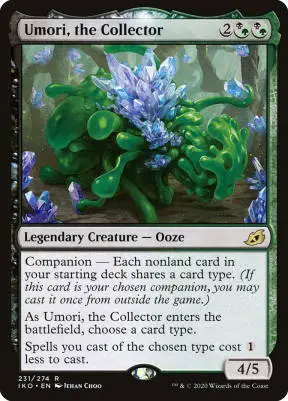
Having a Companion card is basically like starting the game with 8 cards in your hand instead of 7. Constant access to one extra card is huge! Even more importantly, with Companion, you always know what that extra card is going to be, giving your deck an insane boost in consistency.
These payoffs are so big that Wizards of the Coast really needed to make harsh deck-building requirements to balance out the power level. With some Companions, they succeeded. With others, they failed miserably.
Upon Ikoria’s release, Companion creatures began taking over every format in the game. After bannings in Legacy and Vintage, a bigger change was needed.
What Rule Changes Were Made?
As good as Companions are, they used to be so much better. At first, players could cast their Companion straight from their sideboards, without having to pay any extra mana. Wizards quickly realized how overpowered their new creations were. I’m honestly shocked Companions were ever printed with the original rule-set in the first place.
Just two weeks following the release of Ikoria, Wizards announced a rule change.
While Magic rules changes aren’t normally a part of the banned and restricted list updates, in this case, we’re introducing a change to the companion mechanic that is motivated by game balance and metagame share across play environments. Effective with this update, the companion mechanic (and all cards featuring it) will now work differently from before. The new version of the mechanic will work as follows: Once per game, any time you could cast a sorcery (during your main phase when the stack is empty), you can pay 3 generic mana to put your companion from your sideboard into your hand.
Ian Duke, Wizards of the Coast Banned and Restricted Announcment, June 1, 2020
Having to pay three mana to bring your Companion to your hand before you can actually cast it is a big downgrade. This usually slows the player down an entire turn, incentivizing them to play cards they drew naturally instead of casting their Companion. Wizards wanted to take away the oppressive power of Companions, while keeping the intended spirit of the mechanic. To a large extent, they succeeded.
Most of the Companions faded to irrelevancy. The best of the Companions, however, Lurrus of the Dream-Den would continue to terrorize every format, particularly Modern, for nearly two years. Lurus finally received the ban-hammer in March 2022, bringing the Companions reign of terror to an end.
Companion Bans
It all started with Lutri, the Spellchaser. Wizards pre-emptively banned Lutri in Commander before ever releasing Ikoria. This marked the first time in history that Wizards banned a card before actually printing it.
So why would they do that?
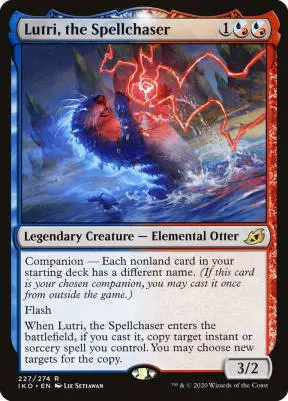
Well, Lutri restricts players to just one copy of each card in their decks instead of four. The Commander format, however, only allows players to include one copy of each spell anyways. Lutri’s downside would have been no downside at all.
Lurrus of the Dream-Den ended up banned for a somewhat similar reason. Lurrus’ restriction forbids you to use any spells with mana-value 3 or higher. However, there are decks in older formats which only want to run spells that cost 2 or less anyways. Lurrus was a completely free extra spell for them, with little to no downside.
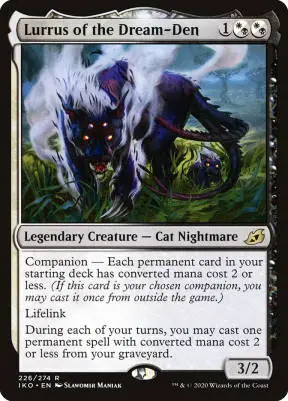
Lurrus has a powerful static ability that allows you to cast one card with mana-value two or less from your graveyard every single turn. A hybrid black/white mana-cost also makes Lurrus available to a crazy number of decks.
Lurrus slots too easily into too many decks, offering powerful card advantage with too little downside.
RELATED: Goodbye Lurrus! Banned and Restricted Changes
Are They Legal In Commander?
Yes, Companions are legal in Commander. Well, aside from Lutri, the Spellchaser, mentioned above. Also, Yorion, Sky Nomad, while legal in Commander, can’t be used as a Companion. Yorion requires you to play with 20 extra cards in your starting deck, and in Commander, you must have 100 cards in your deck, no less, no more.
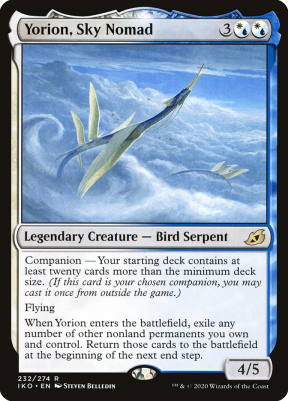
The other eight companions, however, are perfectly legal to play in your EDH deck. Though Companion does function a little differently in Commander than other formats.
Since players don’t have sideboards in Commander, your Companion simply starts outside of the game. Aside from this, the mechanic works basically the same. You still have to abide by all of your companion’s deck-building restrictions. You still pay three generic mana to bring it from outside of the game to your hand. And it still doesn’t count toward your minimum deck size, meaning it’s basically your 101st card.
However, your Companion must still fit within your Commander’s color identity. And, if you use a card as a Companion, you can’t play that same card in your main deck.
Can a Companion Be a Commander?
Yes! All ten Companions are Legendary creatures, which is the only requirement for commanders. Keep in mind, if you do choose a Companion as your commander, you won’t be able to use that same card as a Companion.
You can also play Companions in your main deck. That’s the beauty of the Companion mechanic. It’s completely extra. You can choose to ignore the restrictions (and rewards), and they turn into regular cards.
Are They Good In Commander?
Companion is a bit worse in Commander than other formats. Commander is a singleton format, which means you’ll need to play upwards of 60 unique spells. For comparison, a Standard or Modern deck might run as few as 10-12 unique spells. Having to use so many extra cards makes it a lot harder to follow strict deck-building rules.
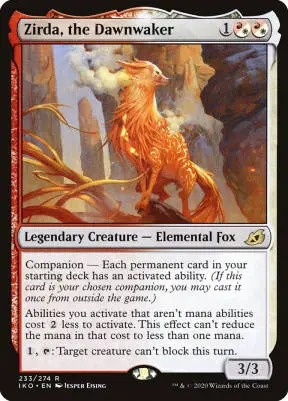
Commander games are also less direct and fast-paced than in other formats. This makes the extra card gained by having a Companion less impactful.
That’s not to say that Companions can’t be good in Commander. All it takes is one adventurous deck-builder to create fireworks. Magic: the Gathering is truly a game of endless possibilities. You’ll just have to work extra hard to pull off the Companion mechanic in Commander.
RELATED:MTG Foretell: How It Works and What It Does
How Is It Different From Partner?
Companion and Partner have some similarities. Instead of affecting gameplay directly, both abilities change the way you build your decks. The Partner mechanic is specific to the Commander format. Companion, on the other hand, is available in various non-rotating formats. And while Companion enforces strict deck-building rules, Partner is much more forgiving. The Partner mechanic doesn’t limit which cards a player can use at all. In fact, it increases your options by allowing you to branch out into extra colors.
How Does Partner Work?
In Commander, players normally must choose only one Legendary creature to serve as their commander. They then build a 99 card deck around that creature, making sure to only use cards within that creature’s color identity.
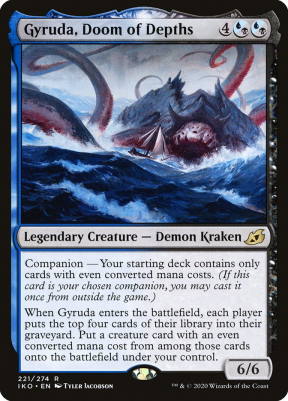
The Partner ability, however, lets you choose two Legendary Creatures to use as Commanders. Both creatures need the Partner ability for this to work. You then get to build a 98 card deck using cards within either of your two commander’s colors.
Since you have access to your commander every game no matter what, having two instead of one is huge. It’s the same fundamental that makes Companion so good: card advantage. Both mechanics give players access to an extra card without using any in-game recourses.
What Companions Are Good Right Now?
Despite the bannings and the nerfed rules, Companions can still be building blocks to powerful decks. After lots of trial and error, the mechanic is finally in a healthy place. Unlocking Companions’ potential without crippling a deck takes a savvy deck builder. Taking on the challenge of building with this mechanic is a blast. Let’s take a look at the best Companions to build with today!
Jegantha, the Wellspring
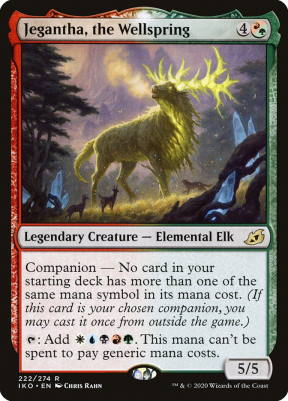
Jegantha, the Wellspring has one of the easiest conditions of all the Companions. As long as no card in your starting deck has more than one of the same mana-symbols in it’s mana cost, Jegantha is a free card every game.
While Jagentha doesn’t have the most impactful ability or stats, you don’t have to give up too much freedom to support it . It also has a painless casting cost, requiring just 4 generic and one hybride green/red. Five mana for a reliable body that produces every color of mana. You could do a lot worse.
Obosh, the Preypiercer
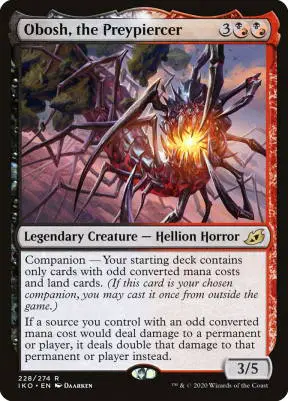
Obosh, the Preypiercer is much more restrictive than some other Companions. Obash only lets you use spells with odd mana-costs, so no two-drops, four-drops, six-drops, and so on. Naturally, there aren’t any pre-existing decks that happen to align with such a random requirement. Aside from Obash, there’s no good reason to exclude even mana-costs in a game of Magic, making it hard to create any synergy.
Luckily, Obash’s ability is powerful enough on its own. If you can meet the requirements, Obash doubles all of the damage you and your permanents inflict!
Kaheera, the Orphanguard
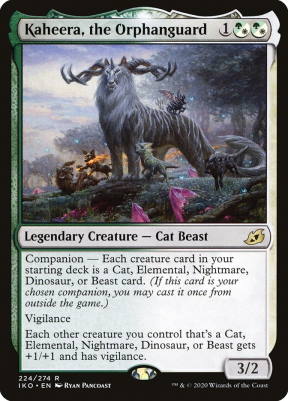
Kaheera, the Orphanguard only works as a Companion if every creature in your starting deck is at least one of five certain creature types:
- Cat
- Elemental
- Nightmare
- Dinosaur
- Beast
This might seem harsh since none of those tribes are particularly strong. But you have to consider, some decks only want to run a very few creatures, or no creatures at all. For them, Kaheera is a completely free extra spell. While a three mana 3/2 Lord might not seem that powerful by itself, it’s still a huge advantage to always have Kaheera up your sleeve.
Kaheera also works with Changelings. Since these shapeshifting creatures count as every creature-type at all times, you can use them to fill gaps in your tribe. Or you can fill your deck entirely with changelings if you want, and you’ll still be able to use Kaheera as a companion. Pretty sneaky, right?
End Step
The Companion mechanic seeks to encourage and reward alternative styles of deckbuilding. Encouraging creativity was always the purpose and the strength of Companions. During the first chapter of their existence, they might have done more harm than good. Now, however, we look towards a new chapter, a chapter full of excitement and possibility.
So what are you waiting for? Get out there and start brewing.
